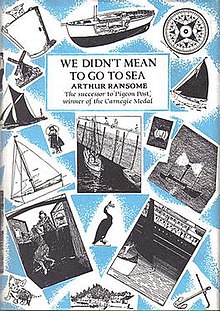We Didn't Mean to Go to Sea
 Typical cover art depicting a montage of Arthur Ransome's own illustrations from the book | |
| Author | Arthur Ransome |
|---|---|
| Cover artist | Arthur Ransome |
| Language | English |
| Series | Swallows and Amazons |
| Genre | Children's books |
| Publisher | Jonathan Cape |
Publication date | 1937 |
| Publication place | United Kingdom |
| Media type | Print (Hardcover & Paperback) |
| ISBN | 978-1-56792-487-9 (David R. Godine, Publisher: paperback, 1994) |
| Preceded by | Pigeon Post |
| Followed by | Secret Water |
We Didn't Mean to Go to Sea is the seventh book in Arthur Ransome's Swallows and Amazons series of children's books. It was published in 1937. In this book, the Swallows (Walker family) are the only recurring characters. They are staying in a new location, Pin Mill on the River Orwell upstream from the ports of Felixstowe and Harwich.
The book features a small sailing cutter, the Goblin, which is almost identical to Ransome's own boat Nancy Blackett. This book also features accurate geography unlike the Lakes books. Ransome sailed Nancy Blackett across to Flushing by the same route as part of his research for the book.
Plot summary
The Walkers help Jim Brading, who was given the sailing cutter Goblin by his uncle, moor her when he misses the buoy. In return he invites them to sail aboard Goblin. Mother agrees provided that they stay within the estuary of the rivers Orwell and Stour, do not pass the Beach End buoy at the mouth of the rivers, and do not go out to sea. These conditions are imposed because of the imminent arrival of their father, Ted Walker, who, after an overseas posting with the Navy, is expected to return by ferry at any time from Holland. He was travelling overland from China; in Swallows and Amazons his ship was at Malta but under orders for Hong Kong (as also stated in Missee Lee).
The children agree to these conditions. However, on the second morning during a calm, the engine runs out of petrol; Jim had used it for some time the night before last. So Jim rows ashore in the Imp the dinghy of the anchored Goblin to fill a can, but does not return. An unexpected bank of fog drifts over the river, and the Goblin is without her captain. Some hours later, after hearing the anchor drag in the fog, the Walkers realise that the tide has risen, the anchor chain is now too short, and they are drifting down river. While attempting to put out more chain, John loses the anchor, and the yacht drifts out beyond Beach End into the North Sea. Aboard the drifting boat, John decides that it is safer to hoist the sails and go farther out to sea rather than stay near the shore among the sandbanks and shoals of the estuary, with the risk of being wrecked in the fog. They put about in the night to return to the river, but find that sailing against the wind is impossible, so run eastward with the wind.
The Goblin sails east through the night in hazardous conditions, being nearly run down as the navigation lights are out of paraffin. John has to leave Susan at the helm while he reefs the mainsail. He is almost swept overboard, but succeeds in his objective. At dawn next morning, John persuades Susan to continue to the nearest port rather than trying to return to Harwich. They rescue a kitten floating on a packing-case. They find themselves approaching an unknown coast; it is the Southern Netherlands. Jim has warned them about longshore sharks who might claim salvage if asked for help. But they see a pilot boat, and pick up a Dutch pilot, who helps them enter the harvbour.
They arrive safely in Flushing at the same time as their absent father is leaving on a ferry to Harwich. Their father leaves the ferry just in time and returns to help them sail the Goblin back. On arriving in England, the Goblin and its crew are reunited with their mother and with Jim Brading, who is looking for his missing yacht. The absent skipper had been unconscious in hospital for two days, suffering from concussion after being involved in a collision with a motor bus.
